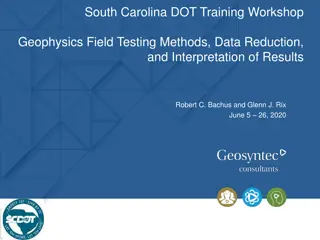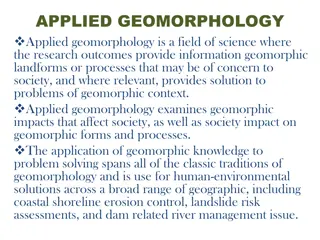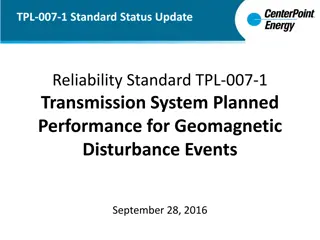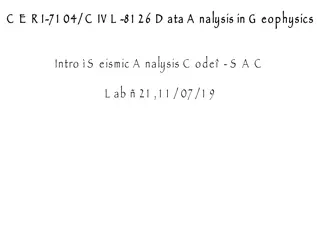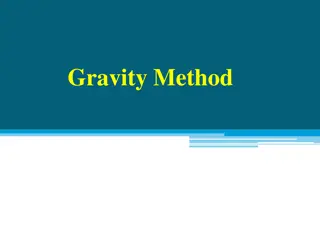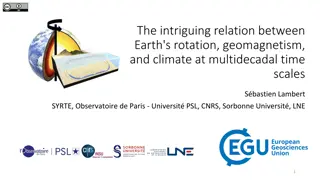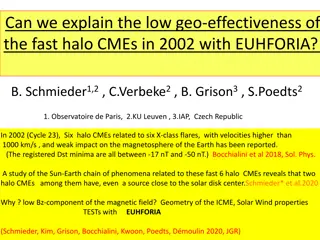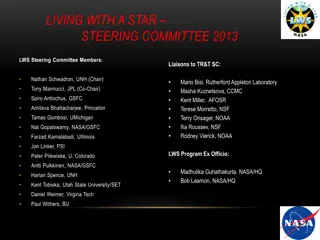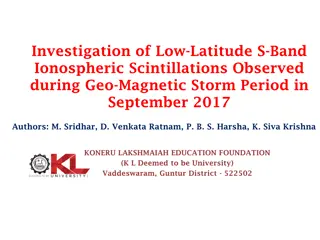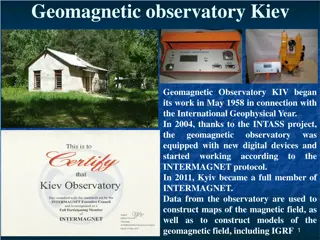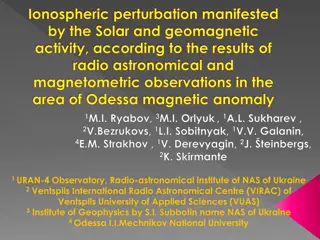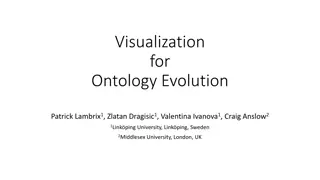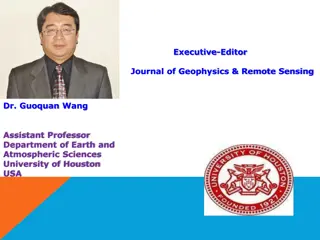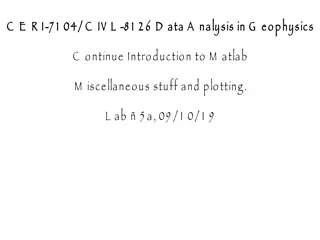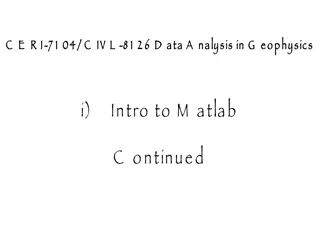Evolution of Geomagnetic Methods in Applied Geophysics and Their Diverse Applications
Explore the rich history of geomagnetic methods from ancient Chinese lodestone use to modern magnetic surveying technologies. Learn about the principles of magnetics surveying, applications in locating metal objects, mapping near-surface features, mineral exploration, and geological bedrock mapping. Understand induced magnetization, magnetic susceptibility, and the total magnetic field in geophysical studies.
Download Presentation

Please find below an Image/Link to download the presentation.
The content on the website is provided AS IS for your information and personal use only. It may not be sold, licensed, or shared on other websites without obtaining consent from the author.If you encounter any issues during the download, it is possible that the publisher has removed the file from their server.
You are allowed to download the files provided on this website for personal or commercial use, subject to the condition that they are used lawfully. All files are the property of their respective owners.
The content on the website is provided AS IS for your information and personal use only. It may not be sold, licensed, or shared on other websites without obtaining consent from the author.
E N D
Presentation Transcript
Geomagnetic method 3rd year geophysical students Course: Applied Geophysics G344 5-6 Lectures Dr. Abdelhady Elakrby
History of Magnetics 2ndCentury BC: Chinese used lodestone (rock rich in magnetite) for direction finding. 12thCentury AD: Magnetic compass in use in Europe. 1600: First scientific analysis of Earth s magnetic field by William Gilbert in book De Magnete. 1640: First use of magnetic measurements to locate iron ore deposits in Sweden. 1870: Development of instrumentation for rapid, accurate measurement of magnetic field by Thal n and Tiberg. 1915: Development of balance magnetometer by Adolf Schmidt. WWII: Rapid development of magnetic surveying technology for mine and submarine detection. 1960s: Sensitive optical absorption magnetometers allow airborne magnetics surveying. 1970s: Development of magnetic gradiometers to measure field difference between two sensors.
Magnetics Surveying Introduction Magnetics surveys measure the magnitude and orientation of the Earth s magnetic field. Magnetic field at Earth s surface depends on field generated in Earth s core, magnetic mineral content of surface materials, and remnant magnetization of surface rocks. Magnetic susceptibility, , is physical parameter to which magnetic surveys are sensitive.
Applications Location of metal objects: Pipes, cables, military ordnance. Mapping near-surface: Archeological sites, concealed mine shafts, igneous intrusions. Mineral Exploration: Identification of metalliferous deposits, for example massive sulphides Geological Bedrock Mapping: Identification of faults and geological boundaries, especially beneath sediment cover.
Induced Magnetization and Magnetic Susceptibility Orbital motions of electrons around atoms nucleus constitute circular electric currents, causing atoms to behave like magnets. Intensity of Magnetization J A body placed in a magnetic field can become magnetised as atoms and molecules align. Net external field as if bar magnet. Magnetic Susceptibility k For low magnetic fields, magnetization J is proportional to the magnetising field H: J = k H where k is called the magnetic susceptibility. Susceptibility is fundamental rock parameter of magnetics prospecting. Magnetic response of rocks determined by amounts and susceptibilities of constituent minerals.
Total Magnetic Field B The Total Magnetic Field B represents the sum of the magnetizing field strength and the magnetization of the medium: B = 0(H + J) = 0(H + H) = r 0H = H where 0is magnetic permeability of free space (4 x10-7H/m) ris relative magnetic permeability is absolute magnetic permeability Clearly, r= 0 B is also called the magnetic flux density or magnetic induction. Magnitude of B represents "closeness" of flux lines. Direction of B along flux lines. Magnetic field measured in volt. s /m2= weber/m2= teslas (T) in SI units. measured in weber/ (amp.m) = henry/m (H/m) In c.g.s system, magnetic flux measured in gauss or gamma 1 = 10-5gauss = 1 nT. In geophysics, magnetic fields are small and measured in nT. Earth s magnetic field varies between 20,000 to 60,000 nT.
Induced and Remnant Magnetisation Induced Magnetisation Induced Magnetisation Jiis produced within a rock in response to an applied external magnetic field. Remnant Magnetisation Magnetic field may exist within rock even in absence of external field due to permanently magnetic particles. This is remnant or permanent magnetization. Interpretation of magnetic data complicated as magnetic field due to a subsurface body results from combined effect of two vector magnetizations that may have different magnitudes and directions.
Diamagnetism and Paramagnetism All atoms have a magnetic moment due to orbit of electrons around nucleus and spin of elections moment (i.e. behave like a small bar magnet). According to quantum theory, two electrons can exist in same electron shell if they have opposite spins. Magnetic moment of paired electrons will cancel out In most materials, no overall magnetisation exists in absence of external field, because the magnetic moments of adjacent atoms are randomly distributed and cancel. Diamagnetism In a diamagnetic material such as halite, all electron shells are complete and no unpaired electrons exist. In an external magnetic field, electrons orbit to produce a weak magnetic field that opposes applied field. Magnetic susceptibility is weak and negative. Paramagnetism In minerals such as olivine, unpaired electrons in incomplete electron shells produce unbalanced magnetic moments. In an external field, magnetic moments align themselves in same direction, producing a weak magnetic field aligned with external. Magnetic susceptibility is weak and positive, but usually an order of magnitude stronger than in diamagnetic materials.
Ferromagnetism In metals such as cobalt, nickel and iron, unpaired electrons are coupled magnetically due to strong interaction between adjacent atoms and overlap of electron orbits. Groups of atoms that couple together magnetically are called magnetic domains, around 1 micron in size. Magnetic domains can be oriented to produce a spontaneous magnetic field in absence of external field. Magnetic susceptibility is large, but depends on temperature and strength of applied field. All domains oriented in same direction. Ferromagnetism disappears if material heated to Curie Temperature, TC, as inter-atomic coupling restricted and domains cannot exist. Behaves as paramagnetic above Cure temperature.
Magnetic Domains Unmagnetized Domains Each domain possesses a random magnetic field orientation. Induced Non-Permanent Ferromagnetism Domains aligned with external field grow at expense of others as external magnetic field increases. Induced Permanent Ferromagnetism Electrons in domains rotate to align with external field as it increases.
Antiferromagnetism and Ferrimagnetism Antiferromagnetism In minerals such as hematite, magnetic domains form, but are aligned in antiparallel fashion. * Magnetic fields cancel out, but crystal lattice defects cause small net field in response to applied external field. * Magnetic susceptibilities are large and positive. Ferrimagnetism In minerals such as magnetite, titanomagnetite, and ilmenite, magnetic domains are antiparallel, but of unequal magnitude. * Net magnetization produced with applied external field. * Magnetic susceptibilities are very large and positive. * Domains can be permanently aligned, producing spontaneous magnetisation that exists after removal of external field. * Ferrimagnetism disappears above Cure temperature.
Magnetization of Ferromagnetic Materials Magnetization For an unmagnetized material with magnetic domains in absence of external magnetic field H, domain orientation related to crystal axes and magnetization cancels out. When external field H is applied, domains reorient themselves in discrete steps to parallel H. Point is reached where no further increase in magnetization, as all domains aligned with external field H. Material is saturated.
Hysteresis Loop in Magnetisation After magnetisation, ferro/ferri-magnetic material retains magnetisation when H decreased to zero, Remnant magnetisation can be removed by external reversing magnetic field. Magnitude of reversed magnetic field HC, the coercivity, needed to eliminate remnant magnetisation is measure of its "hardness" or permanence. Same process can be applied in reverse to return to full positive magnetisation. This process is called a hysteresis loop. Note: Small loop is hysteresis without saturation.
Curie Temperature Cure temperature is temperature at which mineral loses its ferromagnetic behaviour, and any permanent magnetisation is lost. Cure temperature varies with mineral: Titanomagnetite 100-200oC Titanomaghemite 150-450oC Magnetite 550-580oC Hematite 650-680oC Curie temperature is below melting point of rock. In rock such as granite, there will be multiple Curie temperatures for the different minerals present. Low-Temperature Oxidation Oxidation at less than 300oC, tends to increase Curie temperature, as titanomagnetite oxidese towards hematite. Intensity of magnetisation also reduced. Oxidation can affect expected magnetic response of certain rocks.
Magnetic Susceptibilities of Rocks and Minerals Magnetic susceptibility is the physical parameter of magnetics surveying (equivalent to density in gravity). Rocks with significant concentrations of ferri/ferro-magnetic minerals have highest susceptibilities: Ultramafic rocks highest 95,000 200,000 Mafic rocks high 550 122,000 Felsic rocks low 40-52,000 Metamorphic low 0-73,000 Sedimentary very low 0-360
Primary Remnant Magnetization Rocks can become permanently magnetized in the Earth s magnetic field,. It is this that permits tracing past plate motions and locating magnetic ores. Primary remnant magnetization refers to permanent magnetization created during formation of a rock. Thermal Remnant Magnetisation (TRM) TRM acquired when a rock cools through the Curie temperature, e.g. colling of volcanic rock. At Curie temperature, ferro/ferri-magnetic minerals become magnetised in direction of Earth s magnetic field at that time. TRM usually greater than induced magnetisation from present day field. Detrital Remnant Magnetisation (DRM) DRM acquired when fine magnetic particles settle during formation of sedimentary rock, e.g. formation of clays Settling particles are oriented by Earth s magnetic field at that time. DRM << TRM
Secondary Remnant Magnetization Secondary remnant magnetization refers to magnetization acquired later in a rock s history by alteration processes. Chemical Remnant Magnetization (CRM) CRM acquired in situ when magnetic minerals grow or are chemically altered to another form below Curie temperature, e.g. growth of iron oxide in sandstone. Most common in sedimentary and metamorphic rocks. Viscous Remnant Magnetization (VRM) VRM produced by long exposure to ambient field in uniform environment. Buildup of VRM logarithmic with time.
Knigsberger Ratio Remnant magnetization (Jr)may be much greater than that induced by Earth s field today (Ji), e.g. with TRM. K nigsberger Ratio Q is measure of ratio of intensity of remnant to induced magnetization: Q ~ 30-50 for rapidly quenched volcanic rocks Q ~10 for volcanic rocks in general Q~1 for slowly crystallised igneous anmd thermally metamorphosed continental rocks Q<1 in sedimentary and metamorphic rocks when iron not present
Earths Distant Magnetic Field Near the Earth s surface: magnetic field originates largely from currents flowing in the liquid outer core, and the magnetization of surface rocks. Away from the surface: magnetic field is affected by currents caused by the movement of charged particles associated with Van Allen radiation belts. Some of these charged particles are responsible for the Aurora Borealis near the poles. At great distance: the magnetic field is due to charged particles from the sun, the solar wind.
Earths Dipole Field Earth s magnetic field roughly appears as if it originated from a large bar magnet located at the center of the Earth oriented at 11.5oto the axis of rotation.
Earths Magnetic Field Geomagnetic Pole: the position on Earth s surface intersected by the axis of the dipole that fits best the Earth s magnetic field. o North: Hayes Peninsula in northern Greenland o South: Vostok research station in Antarctica Magnetic Pole (or Dip Pole): the position where the magnetic field is vertical o North: North of Bathurst Island in Canadian Arctic o South: 150 km offshore off Adelie coast of Antarctica Geomagnetic and Magnetic Poles differ slightly because Earth s magnetic field is not quite a dipole.
Generation of Earths Magnetic Field Exact mechanism responsible for generation of Earth s magnetic field is not known. Believed to be associated with electrical eddy currents induced within the liquid outer core by its slow internal convection. Secular Variation: Magnetic field is slowly changing due to core processes, e.g. location of south magnetic pole:
Description of Earths Magnetic Field A compass needle free to move in 3-D will point along the magnetic field, i.e. it will point down where field points into Earth. Geomagnetic field can be described by the declination D, the inclination I, and total field vector F. Can calculate (magnetic) latitude, l, from inclination: Earth s Non-Dipolar Field 90% of Earth s magnetic field can be represented by a dipole. Difference between the actual magnetic field and that of the best-fitting dipole is called the non-dipolar field. Features in non-dipolar field with magnitudes of 20,000 nT extending for 1000s km. Non-dipolar field can be represented as 8-12 small dipoles locate radially close to liquid core, simulate cores eddy currents.
International Geomagnetic Reference Field Geomagnetic field can be represented mathematically, and international standard is called International Geomagnetic Reference Field (IGRF). Total field is recalculated every 5 years because of secular variation. Year of calculation is called the epoch. Total field intensity of the IGRF epoch 1980: * A true dipole field would have two maxima, but Earth s magnetic field actually has four. * IGRF excludes effects of near-surface rocks.
Variations in Earths Magnetic Field Geomagnetic Reversals Earth s magnetic field flips polarity unpredictably on geological time scale due to sudden changes in fluid motions in core. Secular Variations Observations of Earth s magnetic field made over 400 years show a gradual change in position of the magnetic pole. Due to slow movement of eddy currents in Earth s core. Diurnal Variations Daily changes in field due to changes in currents of charged particles in ionosphere. Changes are smooth and average around 50 nT. Magnetic Storms Short term disturbances in magnetic field associated with sun spot activity and streams of charged particles from sun. Can be up to 1000 nT in magnitude, and make magnetic surveying impossible.
Instrumentation There are many different types of magnetometers in use today for varrying purposes. For enviromental and engineering investigations the current standards are generally proton procession and cesium vapor. The magnetometer type reflects the physical process by which the magnetic field is measured. Torsion and Balance Magnetometers (Obsolete) Magnetometers measure the total magnetic field FTor the horizontal and/or vertical components of magnetic field, FHand FZ respectively. First magnetometers devised in1640 essentially comprised: a magnetic needle suspended on a wire (Torsion type), or a magnetic needle balanced on a pivot (Balance type) Needle oriented in direction of magnetic field at station location. Adolf Schmidt Variometer Magnetic beam asymmetrically balanced on agate knife edge, and zeroed at base station. Different magnetic field at another station caused displacement of beam, which was measured using collimating telescope. * Had to be oriented perpendicular to magnetic meridien to remove horizontal component of Earth s field. (Use compass?) * Calibrated to read vertical magnetic field component.
Fluxgate Magnetometer Measures component of magnetic field parallel to cores with accuracy of 1-10 nT. Comprises two parallel cores of high ferromagnetic material. Primary coil wound on two cores in series in opposite directions. Secondary coils also wound, but in opposite direction to primary. Operation of Fluxgate Magnetometer An alternating current at 50-1000 Hz is passed through primary coils, producing magnetic field that drives each core to saturation through a Magnetization hysteresis loop. * With no external magnetic field, cores saturate every half cycle. Voltages induced in secondary coils have opposite polarity as coils wound in opposite directions. So zero net voltage. In Earth's magnetic field, component of field parallel to cores causes one core to saturate before the other, and voltages in secondary coils do not cancel.
Operation of Fluxgate Magnetometer An alternating current at 50-1000 Hz is passed through primary coils, producing magnetic field that drives each core to saturation through a magnetization hysteresis loop. With no external magnetic field, cores saturate every half cycle. Voltages induced in secondary coils have opposite polarity as coils wound in opposite directions. So zero net voltage. In Earth's magnetic field, component of field parallel to cores causes one core to saturate before the other, and voltages in secondary coils do not cancel. Principle of Operation of Fluxgate Magnetometer Principle behind operation is Faraday s Law of Induction (twice) Voltage induced in secondary coil proportional to magnetic field generated in ferromagnetic core. When core saturated, magnetic field does not change, and no voltage is induced in secondary coil.
Proton Precession Magnetometer Uses sensor consisting of bottle of proton-rich liquid, usually water or kerosene, wrapped with wire coil. Protons have a net magnetic moment, and so are oriented by Earth s magnetic field or an applied field. Measures precession as protons reorient to Earth s field. Precession frequency proportional to total field strength. As sensor bottle 15 cm long, accuracy of measurement is reduced in areas of high magnetic field gradient. Measures total field strength, so instrument orientation not important, unlike fluxgate. Overhauser Effect adds electron-rich fluid to enhance polarisation effect, and increase accuracy. Two sensors indicate a gradiometer Principle of Operation of Proton Magnetometer A. In ambient field, majority of protons aligned parallel to field, remainder antiparallel. B) Current in coil generates strong magnetic field at right angles to Earth s field, causing all protons to align. C.When current turned off protons precess back to orientation of Earth s field. Protons are charged particles, and create magnetic field, which alternates as proton precesses. Current induces alternating voltage in coil at precession frequency. C.Measuring frequency of current in coil gives magnitude of Earth s total magnetic field as it is proportional to precession frequency. Measuring current frequency to 0.004 Hz gives field to 0.1nT.
Airborne and Seaborne Magnetometers Proton precession magnetometers are used extensively in marine and airborne surveys: At sea: sensor bottle is towed in a "fish" 2-3 ship s length astern to remove it from magnetic field of ship In air: sensor is towed 30 m behind aircraft or placed in a "stinger" on nose, tail or wingtip. Often active compensation for magnetic effect of aircraft is calculated. Advantage: Aeromag is rapid, cost-effective method for covering large areas. Magnetic Gradiometers Gradiometers use two sensors separated by fixed distance to measure gradient of the Earth s magnetic field: In airborne work, separation is 2-5 m for stinger, up to 30 m for bird. In ground work, separations of 0.5 m are common. Example of 3-axis gradiometer system: Advantages: No correction for diurnal variation required as measurement is difference off two magnetic sensors. Vertical gradient measurements emphasise shallow anomalies and suppress long wavelength features.
Magnetic Surveying - Data Acquisition Ground Surveys Ground magnetic measurements are usually made with portable instruments at regular intervals along more or less straight and parallel lines that cover the survey area. Often the interval between measurement locations (stations) along the lines is less than the spacing between lines. Ideally lines should be perpendicular to strike, with a few along strike tie-lines. Establish base-station to monitor diurnal variations every 0.5-1.0 hours. Avoid readings near metal objects such as railway tracks, cars... Avoid wearing metal objects, such as watch, geological hammer. Data recording methods will vary with the purpose of the survey and the amount of noise present. Methods include taking three readings and averaging the results, taking three readings within a meter of the station and either recording each or recording the average. Some magnetometers can apply either of these methods and even do the averaging internally. An experienced field geophysicist will specify which technique is required for a given survey. In either case, the time of the reading is also recorded unless the magnetometer stores the readings and times internally.
Items to be recorded in the field book for magnetics include: a) Station location, including locations of lines with respect to permanent landmarks or surveyed points. b) Magnetic field and/or gradient reading. c) Time. d) Nearby sources of potential interference. The experienced magnetics operator will be alert for the possible occurrence of the following: 1. Excessive gradients may be beyond the magnetometer's ability to make a stable measurement. Modern magnetometers give a quality factor for the reading. Multiple measurements at a station, minor adjustments of the station location and other adjustments of technique may be necessary to produce repeatable, representative data. 2. Nearby metal objects may cause interference. Some items, such as automobiles, are obvious, but some subtle interference will be recognized only by the imaginative and observant magnetics operator. Old buried curbs and foundations, buried cans and bottles,
Airborne Surveys Estimate line spacing to avoid significant signal aliasing for aircraft height. Approximate rule of thumb for maximum line spacing for particular application: Note that h is flight height above magnetic basement, not Earth s surface. Reduction of Magnetic Survey Data Magnetics data reduction is usually simpler than with gravity, comprising: 1. Diurnal Correction 2. Geomagnetic Correction 3. Elevation/Terrain Correction (occasionally) Diurnal Variation Similar to tidal correction in gravity Reading is recorded at base station during survey, and then corrections applied to survey data.
The base-station memory magnetometer, when used, is set up every day prior to collection of the magnetic data. Ideally the base station is placed at least 100 m from any large metal objects or traveled roads and at least 500 m from any power lines when feasible. The base station location must be very well described in the field book, as others may have to later locate it based on the written description. As the base may vary by 10 to 25 nT or more from day to day, this correction ensures that another person using the same base station and the same asserted value will get the same readings at a field point to within the accuracy of the instrument. This procedure is always good technique but is often neglected by persons interested in only very large anomalies (> 500 nT, etc.). Difficult to return to base station in airborne work: possible to estimate diurnal correction from line intersections especially with additional tie lines
Geomagnetic Correction Similar to latitude correction in gravity: Earth s total magnetic field varies from 25,000 nT at equator to 69,000 nT at poles Three possible correction methods: 1) Subtraction of IGRF: Earth s theoretical magnetic field is removed from survey data by subtracting IGRF 2) Linear approximation to IGRF: Earth s field is approximated by linear variation across survey area, and subtracted: For example, in UK IGRF is approximated by 2.13 nT/km north, and 0.26 nT/km west. 3.Regional correction: With large surveys, regional trend can be estimated and removed to leave residual anomaly, as with gravity data. Terrain Correction There are no elevation corrections (equivalent to Free-air and Bouguer corrections) with magnetic data as gradient is only 0.035 nT/m at poles, 0.015 nT/m at equator. Terrain corrections can be applied, but are complicated. Require estimate of ground susceptibility, and topography.
Waiting me in 7-8 lectures in Geoelectric method & 9-10 lectures in Seismic method



